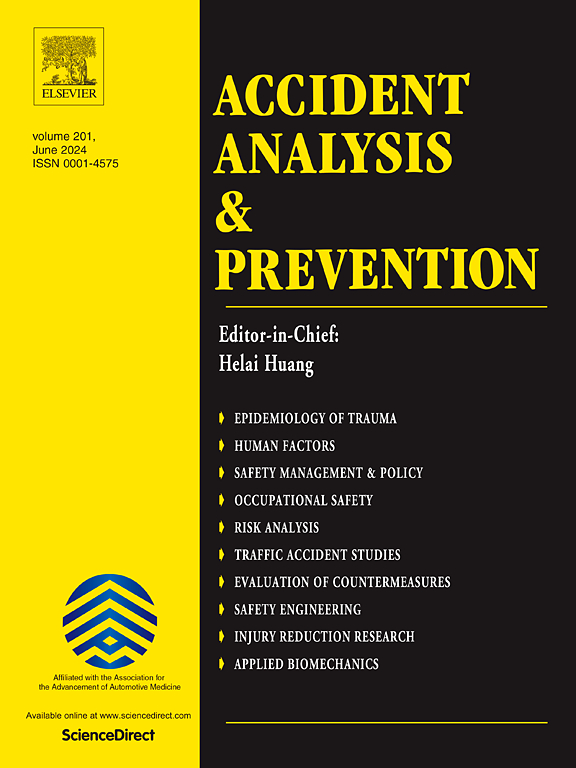道路环境美学是否会影响自动驾驶汽车的危险驾驶行为?利用可解释机器学习和异质性随机参数多项式逻辑对道路准备度的评估。
IF 5.7
1区 工程技术
Q1 ERGONOMICS
引用次数: 0
摘要
美学一直是道路环境设计的高级要求,因为它可以为人类驾驶员提供愉快的驾驶体验,引导更好的驾驶行为。然而,目前尚不清楚基于美学的道路环境设计是否也会对自动驾驶汽车(AVs)产生影响,这导致目前的自动驾驶汽车(RRAV)道路准备评估模型没有考虑道路环境美学。因此,本研究旨在探索道路环境美学与自动驾驶汽车危险驾驶行为(RDBAV)之间的关系,并从道路环境美学的新视角提出RRAV评价模型。利用真实的自动驾驶数据,获得1491个纵向RDBAV事件和225个横向RDBAV事件以及相应的道路环境图像。建立了道路环境美学的定量模型,从自然性、生动性、多样性和统一性四个方面提取了38个相关特征变量。然后,采用XGBoost (eXtreme Gradient Boosting)与SHAP (SHapley Additive exPlanation)相结合的可解释机器学习,以RDBAV的发生为因变量,道路环境美学特征变量为自变量,建立RRAV的评价模型。结果表明,基于xgboost的RRAV评价模型优于其他常用方法,纵向和横向RRAV预测准确率分别为96.9%和91.8%。由于SHAP的优势,基于全局和个体特征贡献,计算和解释道路环境美学特征对RDBAV的影响程度。此外,均值和方差均具有异质性的随机参数多项logit模型表明,“中间场景”左侧视觉曲线长度指标和主色指标在纵向RDBAV分析中具有显著的异质性。本研究结果将有助于从新的美学角度对自动驾驶汽车进行准确评价,开发仿人的自动驾驶汽车视觉感知系统,优化基于美学的道路环境设计。本文章由计算机程序翻译,如有差异,请以英文原文为准。
Does road environment aesthetics influence risky driving behavior of autonomous vehicles? An evaluation on road readiness using explainable machine learning and random parameters multinomial logit with heterogeneity
Aesthetics has always been an advanced requirement in road environment design, because it can provide a pleasant driving experience and guide better driving behavior for human drivers. However, it remains unknown whether aesthetics-based road environment design also has an impact on autonomous vehicles (AVs), resulting in that current evaluation models on road readiness for AVs (RRAV) do not consider road environment aesthetics. Therefore, this study aims to explore the relationship between road environment aesthetics and risky driving behavior of AVs (RDBAV) and propose an RRAV evaluation model from the new perspective of road environment aesthetics. Using real autonomous driving data, 1,491 longitudinal RDBAV events and 225 lateral RDBAV events are acquired together with corresponding road environment images. A novel quantitative model of road environment aesthetics is developed and 38 relevant feature variables are extracted from four aspects, including Naturalness, Vividness, Variety, and Unity. Then, an explainable machine learning that combines XGBoost (eXtreme Gradient Boosting) with SHAP (SHapley Additive exPlanation) is employed to establish an evaluation model of RRAV, by treating the occurrence of RDBAV as the dependent variable and feature variables of road environment aesthetics as independent variables. The results show that this XGBoost-based RRAV evaluation model performs better than other commonly-used methods, with accuracies of 96.9% and 91.8% for longitudinal and lateral RDBAV prediction, respectively. Due to the advantages of SHAP, the influence degrees of aesthetic features of road environments on RDBAV are calculated and explained based on global and individual feature contributions. In addition, a random parameters multinomial logit model with heterogeneity in means and variances reveals that the indicator of left visual curve length in the “middle scene” and the indicator of dominant color have significant heterogeneity for the analyses of longitudinal RDBAV. The findings of this study might contribute to the accurate evaluation of RRAV from the new viewpoint of aesthetics, the development of human-like visual perception systems of AVs, and the optimization of aesthetics-based road environment design.
求助全文
通过发布文献求助,成功后即可免费获取论文全文。
去求助
来源期刊

Accident; analysis and prevention
Multiple-
CiteScore
11.90
自引率
16.90%
发文量
264
审稿时长
48 days
期刊介绍:
Accident Analysis & Prevention provides wide coverage of the general areas relating to accidental injury and damage, including the pre-injury and immediate post-injury phases. Published papers deal with medical, legal, economic, educational, behavioral, theoretical or empirical aspects of transportation accidents, as well as with accidents at other sites. Selected topics within the scope of the Journal may include: studies of human, environmental and vehicular factors influencing the occurrence, type and severity of accidents and injury; the design, implementation and evaluation of countermeasures; biomechanics of impact and human tolerance limits to injury; modelling and statistical analysis of accident data; policy, planning and decision-making in safety.
 求助内容:
求助内容: 应助结果提醒方式:
应助结果提醒方式:


